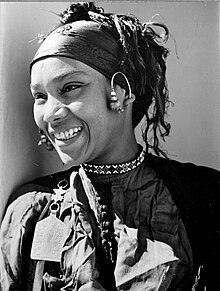 | |
| Total population | |
|---|---|
| > 1.5 million | |
| Regions with significant populations | |
| (40%) An ethnic group in ( | |
| Languages | |
| Maghrebi Arabic Berber languages | |
| Religion | |
| Sunni Islam | |
| Related ethnic groups | |
| Gnawa, other Afro-Arabs, Beidane, Sahrawis, other Maghrebi Arabs, other Arab, Berber, Arab-Berber, and Arabized Berber peoples, Tuareg, other Maghrebis |
The Haratin (Arabic: حراطين, romanized: Ḥarāṭīn, singular Ḥarṭānī), also spelled Haratine or Harratin, are an ethnic group found in western Sahel and southwestern Maghreb.[1][2][3] The Haratin are mostly found in modern Mauritania (where they form a plurality), Morocco, Western Sahara, and Algeria. In Tunisia and Libya, they are referred to as Shwashin (Chouachin, Chouachine; singular: Shwashin, Chouchan).
The Haratin speak Maghrebi Arabic dialects as well as various Berber languages.[4] They have traditionally been characterized as the descendants of former Sub-Saharan slaves.[5][6]
They form the single largest defined ethnolinguistic group in Mauritania where they account for 40% of the population (~1.5 million).[7] In parts of Arab-Berber Maghreb, they are sometimes referred to as a "socially distinct class of workers".[4][8]
The Haratin have been, and still commonly are socially isolated in some Maghrebi countries, living in segregated, Haratin-only ghettos. They are commonly perceived as an endogamous group of former slaves or descendants of slaves.[9][10] They converted to Islam under the Arabs and Berbers[9] and were forcibly recruited into the Moroccan army by Ismail Ibn Sharif (Sultan of Morocco from 1672–1727) to consolidate power.[10]
Traditionally, many Haratin have held occupations in agriculture – as serfs, herdsmen, and indentured workers.[9]
- ^ Chouki El Hamel (2014). Black Morocco: A History of Slavery, Race, and Islam. Cambridge University Press. pp. 110–113. ISBN 978-1-139-62004-8.
- ^ Sabine, Partouche. "L'Encyclopédie berbère". Institut de recherches et d'études sur les mondes arabes et musulmans Iremam - UMR 7310. Archived from the original on 25 February 2018. Retrieved 25 February 2018.
- ^ Jacques-Meunie, Denise (1972). "L'Notes sur l'histoire des populations du sud marocain". Revue de l'Occident Musulman et de la Méditerranée. 11: 137–150. doi:10.3406/remmm.1972.1148. Retrieved 25 February 2018.
- ^ a b they are Arabic speaking Haratin, Encyclopædia Britannica (2014)
- ^ Keita, S. O. Y. (1993). "Studies and Comments on Ancient Egyptian Biological Relationships". History in Africa. 20: 129–154. doi:10.2307/3171969. ISSN 0361-5413. JSTOR 3171969. S2CID 162330365.
- ^ McDougall, E. Ann (2015). "Hidden in Plain Sight: "Haratine" in Nouakchott's "Niche-Settlements"". The International Journal of African Historical Studies. 48 (2): 251–279. ISSN 0361-7882. JSTOR 44723360.
- ^ Mauritania, CIA Factbook
- ^ John A. Shoup III (2011). Ethnic Groups of Africa and the Middle East: An Encyclopedia: An Encyclopedia. ABC-CLIO. pp. 114–115. ISBN 978-1-59884-363-7.
- ^ a b c Anthony Appiah; Henry Louis Gates (2010). Encyclopedia of Africa. Oxford University Press. p. 549. ISBN 978-0-19-533770-9., Quote: "Haratine. Social caste in several northwestern African countries consisting of blacks, many of whom are former slaves (...)"
- ^ a b Meyers, Allan R. (1977). "Class, Ethnicity, and Slavery: The Origins of the Moroccan 'Abid". The International Journal of African Historical Studies. 10 (3). Boston University African Studies Center: 427–442. doi:10.2307/216736. JSTOR 216736.